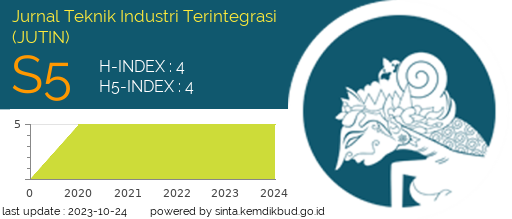Perancangan Alat Bantu Penghitung sekaligus Pencacah Limbah Tutup Botol Minuman Plastik Yang Ergonomis Di Desa Sipungguk, Kecamatan Salo
DOI:
https://doi.org/10.31004/jutin.v6i1.23795Abstract
Community participation in processing waste can start from separating organic and non-organic waste bins to implementing the concept of reduce, reuse and recycle (3R) which provides added value. Organic waste can become compost which is useful in agriculture and non-organic waste can be made into handicrafts such as bags, flower vases, pots, accessories, key chains, toys and so on from plastic drink bottle caps. Crafts from waste plastic bottle caps are one way to process plastic waste. The amount that can be produced depends on the creativity and inventiveness of the craftsman and the price is in accordance with the level of difficulty in making crafts that have selling value. In the small industry of plastic waste craftsmen, Mr. Anto is someone whose job is to collect used plastic bottle caps which will be resold to craftsmen. At Mr. Anto's place, he has three main activities in choosing plastic bottle caps. His activities are pressing the bottle caps, cutting the tip of the bottle caps, and counting the bottle caps. When counting bottle caps, the tool used consists of 2 parts, namely a base or container and a checker-shaped counter that can count bottle caps per 10 doses. The container is box-shaped and made of plywood and wood with a thickness of 1 cm on the right, left and back edges, while the chopper is in the shape of boxes totaling 120 boxes and is made of plywood. Apart from calculating plastic bottle caps, it is also used to determine the dimensions of bottle caps after cutting the ends according to standards. This calculation is needed to find out how many bottle caps the worker has worked on as a basis for calculating the salary the worker gets each weekDownloads
Published
2023-04-29
How to Cite
Sari, R. K., Aliza, N., & Adeswastoto, H. (2023). Perancangan Alat Bantu Penghitung sekaligus Pencacah Limbah Tutup Botol Minuman Plastik Yang Ergonomis Di Desa Sipungguk, Kecamatan Salo. Jurnal Teknik Industri Terintegrasi (JUTIN), 6(1), 369–378. https://doi.org/10.31004/jutin.v6i1.23795
Issue
Section
Articles of Research
License

This work is licensed under a Creative Commons Attribution-ShareAlike 4.0 International License.






